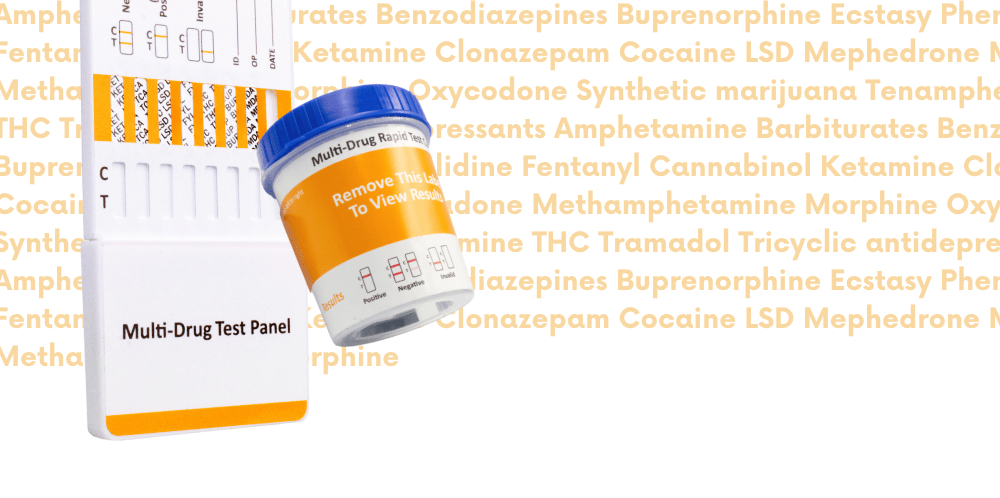
EZCHEK Urine Analyzer: Speed, Precision, and Convenience in Diagnostics
Urine analysis is one of the fundamental diagnostic tools used in medicine. It helps identify various health problems and monitor patient conditions. In today’s times,

Knowledge about these parameters allows us to make informed decisions regarding our health and safety.
We often hear different names of psychoactive substances in the media or conversations, but we don’t always realize what they really are and how they work. In this blog post, we would like to provide a more detailed and medical explanation regarding selected parameters detected in our drug tests.
Our goal is to provide reliable medical information to ensure a complete understanding of these substances. By doing so, we can make more informed decisions regarding our health and avoid potential dangers associated with the use of psychoactive substances.
Amphetamine is a powerful stimulant that acts on the nervous system. It is typically used by individuals seeking increased stimulation, improved concentration, or a sense of euphoria. It can be taken orally, inhaled, or injected. Amphetamine increases the release of neurotransmitters such as norepinephrine and dopamine, resulting in increased energy and reduced fatigue.
Barbiturates are a group of drugs with sedative and sleep-inducing effects. In the past, they were commonly used as sleep aids and anticonvulsants. However, due to the risk of addiction and adverse effects, their use has been significantly limited. Barbiturates act on the nervous system by suppressing brain activity, leading to calming effects.
Benzodiazepines are a group of drugs used in the treatment of anxiety, insomnia, seizures, and muscle tension. They work by enhancing the action of a neurotransmitter called gamma-aminobutyric acid (GABA), leading to muscle relaxation, calming effects, and reduced brain activity. Benzodiazepines are widely used but can cause addiction and have a potential for misuse.
Buprenorphine is primarily used in the treatment of opioid addiction, such as heroin or morphine. It is often employed in opioid substitution therapy programs. Buprenorphine acts as a partial agonist on opioid receptors, helping to alleviate opioid withdrawal symptoms and reduce the craving for opioids.
Ecstasy, also known as MDMA, is a psychoactive substance belonging to the amphetamine group. It is often used recreationally due to its euphoric and empathogenic properties. Ecstasy affects neurotransmitters such as serotonin, dopamine, and norepinephrine, resulting in increased feelings of closeness and euphoria.
Phencyclidine (PCP) is a dissociative substance that was originally used as an anesthetic. Its psychoactive effects can lead to cognitive disturbances, spatial disorientation, and a sense of detachment from reality.
Fentanyl is a potent opioid that is much stronger than morphine. It is used in pain therapy but also has potential for abuse. It acts on opioid receptors, causing a reduction in pain perception and a sense of euphoria. However, due to its strong potency, there is a high risk of overdose and life-threatening side effects.
Tetrahydrocannabinol (THC) is the main psychoactive component of marijuana. It acts on cannabinoid receptors in the brain, causing changes in mood, perception, memory, and cognitive functions. THC can have both calming and stimulating effects and can also affect appetite.
Ketamine is a psychoactive substance that can act as both a stimulant and a hallucinogen. It is used in medicine as an anesthetic but also has potential for abuse. Ketamine acts on NMDA receptors in the brain, causing changes in perception, consciousness, and mood.
Clonazepam is a benzodiazepine primarily used in the treatment of anxiety disorders and epilepsy. It has calming, muscle-relaxing, and anticonvulsant effects. However, long-term use of clonazepam can lead to dependence and tolerance.
Cocaine is a powerful stimulant that has stimulating effects on the nervous system. It is derived from coca leaves and can be used as a powder for inhalation (referred to as “cocaine”) or in a form for injection (referred to as “crack”). Cocaine acts on neurotransmitters such as norepinephrine, dopamine, and serotonin, causing a sense of euphoria and increased energy.
12. LSD:
LSD (lysergic acid diethylamide) is a powerful psychedelic that affects perception, thinking, and emotional states. LSD acts on serotonin receptors in the brain, causing intense hallucinations and alterations in consciousness.
Mephedrone is a psychoactive substance also known as “meph” . It is a synthetic stimulant with effects similar to amphetamines. Mephedrone can induce feelings of euphoria, stimulation, increased energy, and reduced fatigue. However, it can also be associated with serious side effects and the risk of addiction.
14. Methadone:
Methadone is an opioid primarily used in opioid substitution therapy for individuals addicted to stronger opioids such as heroin. It acts on opioid receptors, alleviating withdrawal symptoms and reducing opioid cravings. Methadone has a longer duration of action compared to other opioids, allowing for controlled therapy.
Methamphetamine is a potent stimulant that affects the central nervous system. Similar to amphetamines, it increases the release of norepinephrine and dopamine, resulting in heightened energy, stimulation, and euphoria. Methamphetamine can be taken orally, inhaled, or injected.
Morphine is a potent opioid used for pain relief. It acts on opioid receptors, reducing pain perception and inducing a sense of well-being. Morphine can also be used recreationally due to its euphoric effects, but it carries a high risk of addiction.
Oxycodone is a strong opioid used for pain relief. It acts on opioid receptors, reducing pain perception and inducing a sense of well-being. Oxycodone can also be used recreationally and has a high risk of addiction.
Synthetic marijuana, also known as “k2” or “spice,” is a mixture of chemical substances that mimic the effects of cannabinoids. These substances are often sold as a substitute for marijuana, but their composition and effects can be unpredictable and hazardous to health. Side effects of synthetic marijuana can be severe, such as hallucinations, cardiovascular issues, and mental health problems.
Tenamphetamine, also known as “methylenedioxymethamphetamine” (MDMA), is a psychoactive substance from the amphetamine group. It is often used recreationally due to its euphoric and empathogenic properties. Tenamphetamine affects neurotransmitters such as serotonin, dopamine, and norepinephrine, resulting in increased feelings of closeness and euphoria.
THC is the primary psychoactive component of marijuana. It acts on cannabinoid receptors in the brain, leading to changes in mood, perception, memory, and cognitive functions. THC can have both calming and stimulating effects and can also affect appetite.
Tramadol is an opioid used for pain management. It acts on opioid receptors, reducing pain sensations. Tramadol also has antidepressant effects but can lead to dependence and opioid-related side effects.
22. Tricyclic Antidepressants:
Tricyclic antidepressants are a group of medications used in the treatment of depression. They work by altering the levels of neurotransmitters such as serotonin and norepinephrine in the brain. They have calming and antidepressant effects but are also associated with various side effects.
In conclusion, understanding the parameters detected by drug tests is crucial for identifying the presence of substances in the body and understanding their potential health effects. Knowledge about these parameters allows us to make informed decisions regarding our health and safety.

Urine analysis is one of the fundamental diagnostic tools used in medicine. It helps identify various health problems and monitor patient conditions. In today’s times,

What’s new about COVID-19? Dr Tzoulis P from the Medical School of London published a paper in JCEM showing that people with COVID-19 and low

The current situation on the market is difficult for all entrepreneurs, although there is no doubt that the automotive industry is one of those that
Company